
Employee turnover rates explained
 Tyler Munro
Tyler Munro
Tyler Munro is the director of brand and content at ZayZoon. He has previously led content marketing teams at OneTrust, Flybits and integrate.ai. In his spare time, Tyler writes literary fiction. His work has appeared in Yemassee Review and decomP, among others. He's also been nominated for the Pushcart Prize.
Like they say, nothing in life is certain except death and taxes... and employee turnover.
Even Alphabet (Google) struggles to retain employees—and they're consistently rated one of the best places to work on the planet.
That's all to say that if you find yourself fretting over employee turnover, remember: You're in very, very good company.
If you're reading this, you're probably an IC looking for smart ways to improve retention. Or maybe you're a people leader trying to curb runaway turnover rates. Whatever the case, today I'm going to do my best to set you up for success.
So, let's talk game plan.
First thing, we're going to unpack everything you need to know about turnover rates, including how to calculate turnover. We'll even look at the most recent benchmarks, so you can see exactly how you're doing compared to other businesses. Then, we'll break down the key causes of high turnover and what you can do about them.
Alrighty then, let's do this.
What is turnover rate?
If you're a bit fuzzy on what turnover rate is, here's the Coles Notes version:
Employee turnover rate is the number of employees who leave a business over a certain period of time. Typically, human resources teams will measure employee turnover on a quarterly basis. Some will even track it on a departmental level.
By now, you're probably wondering what a good (or bad) employee turnover rate is. So, let's take a look at industry benchmarks, based off the most recent LinkedIn data.
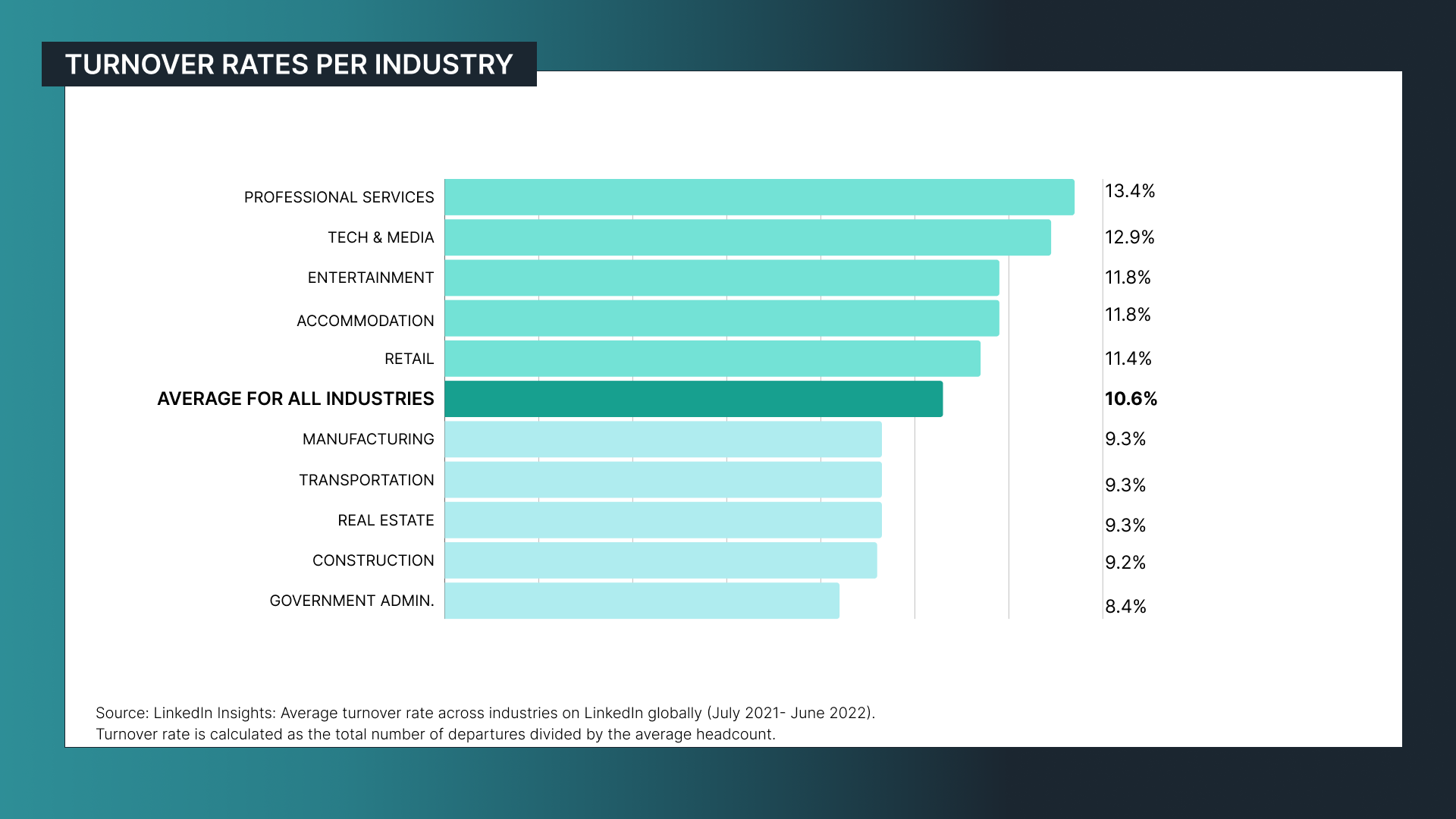
In terms of high employee turnover rates, professional services leads the pack at 13.4%. On the opposite end of the spectrum, government admin scores the lowest turnover rate—8.4%.
Now, for the average. Across all industries, the average employee turnover rate is 10.6%. If this number looks familiar to you, then great. You're average. Of course, if you're reading this, you're not content with average. You want to be exceptional.
If you already have a healthy turnover rate, kudos. That said, there's always room for improvement, which is probably why you're here.
Finally, to those who are struggling with a high turnover rate, you've got this. And we'll explain why a little later.
Involuntary turnover rate versus voluntary turnover rate
A point of clarification.
There are actually TWO types of turnover (and turnover rates to measure them).
They are:
Involuntary turnover rate: The number of employees who involuntarily leave your business (i.e. are terminated) over a given period.
Voluntary turnover rate: The number of employees who voluntarily leave your business (i.e. quit) over a certain period of time.
It's important to remember that employee turnover rate combines both of these. And while one might seem preferable to the other, keep in mind that a high count in both speaks to an underlying mismatch between employee and employer.
How to calculate employee turnover rate
Thankfully, we don't have to spend too much time here, which is a good thing because math isn't my strong suit.
To calculate employee turnover rate, you'll want to:
-
Calculate the average number of employees over a specific time period. To do this, just add up the number of employees at the beginning of a time period and at the end of a given period, then simply divide by two.
-
Calculate employee turnover. Next, you'll want to find out how many employees left your organization over your given time period. Simply subtract the number you had at the beginning o that time period from the number you had at the end.
-
Calculate employee turnover rate. Okay, to determine your actual turnover rate, you'll want to divide employee turnover by the average number of employees, then multiply by 100. Remember, you can calculate employee turnover rate for your whole organization, but you can also do so at the departmental level. You might want to do this to figure out where staff turnover is highest.
And for all those visual learners out there, here's the employee turnover rate formula:
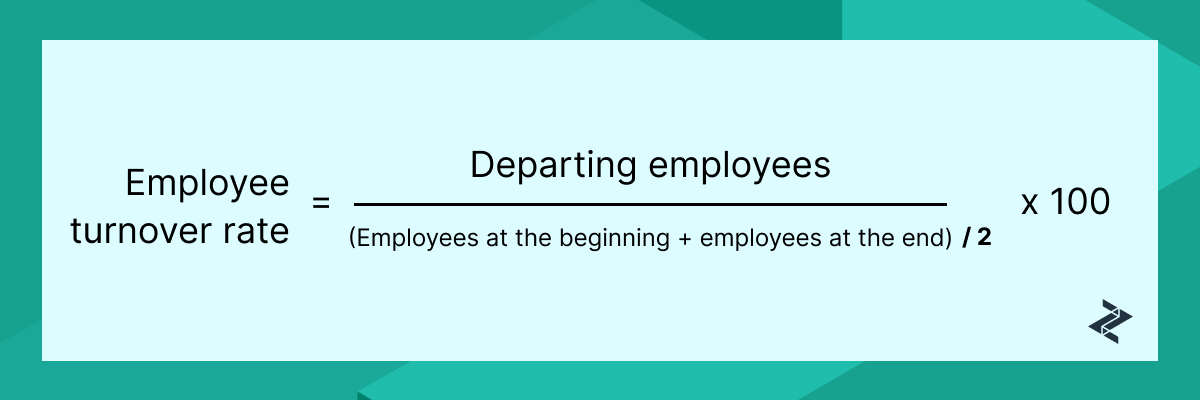
Now that we've unpacked what employee turnover rate is and how to calculate it, let's investigate how it can actually impact your business.
The impact of high employee turnover on your business
Okay, this is where things get real.
Let's look at how high employee turnover will affect your business.
Decreased productivity
If you've got a revolving door of employees, productivity is going to go straight out the window. I mean, that's a no-brainer, right? But how can we actually quantify this?
Thankfully, Stephen King, president and CEO of GrowthForce (and not the famous horror writer of the same name), has crunched the numbers. According to him, it takes two to three months to replace a worker, then another month or two to get them to full productivity.
So, if an employee who left was bringing in $60,000 in revenue, your company will lose about $15,000 in profits for the next three months. And this doesn't factor in the time spent training that new hire or the added burden existing employees will have to take on as your new hire gets up to speed.
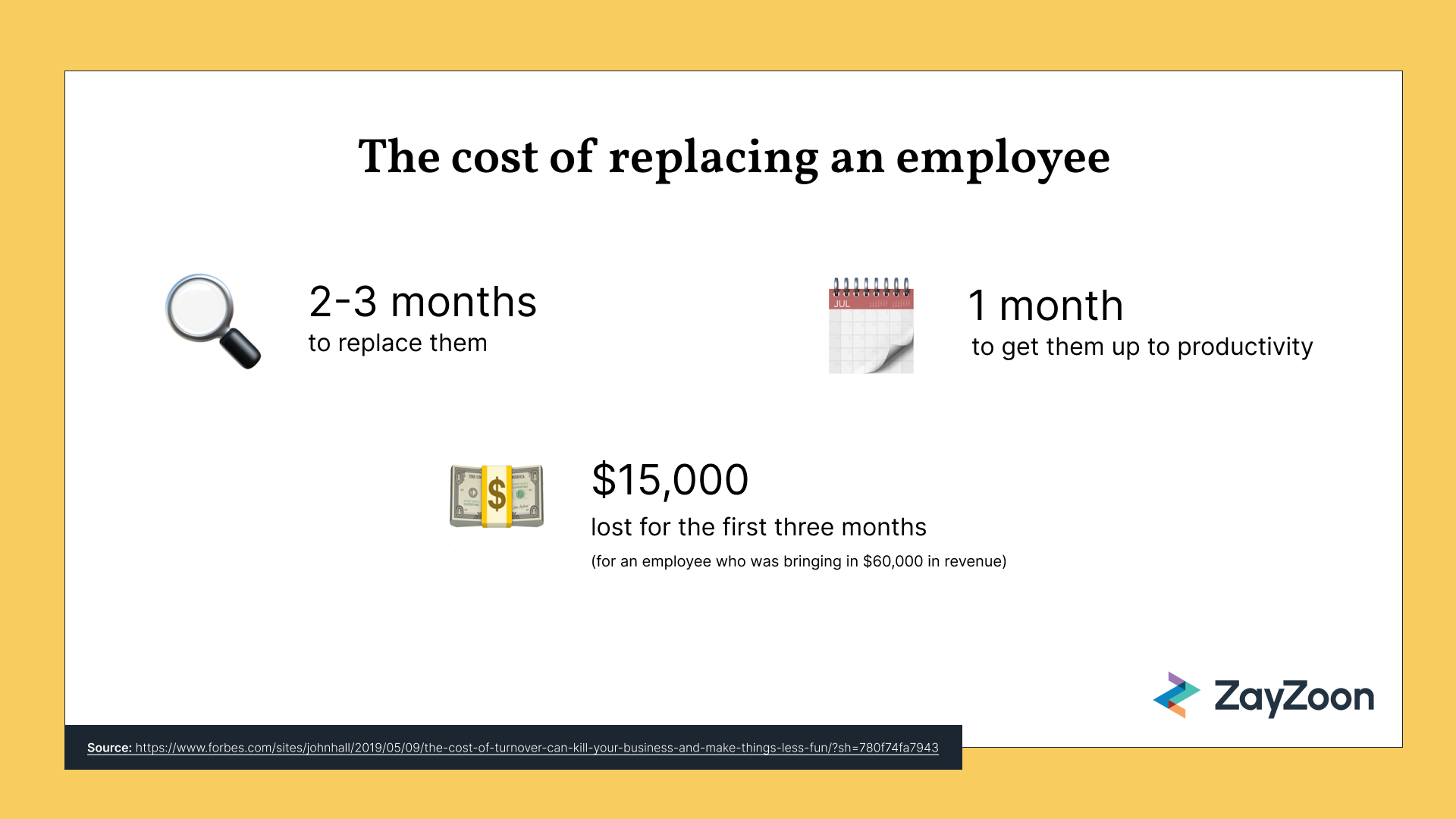
Increased recruitment and training costs
If you're constantly losing talent, you're spending more money filling vacant positions and training new hires. Employee Benefits News reports that it costs 33% of a worker's annual salary to hire a replacement if that worker decides to leave. It's easy to see how HR and your recruiting team more specifically can become a MASSIVE cost centre if you don't keep those turnover rate numbers down.
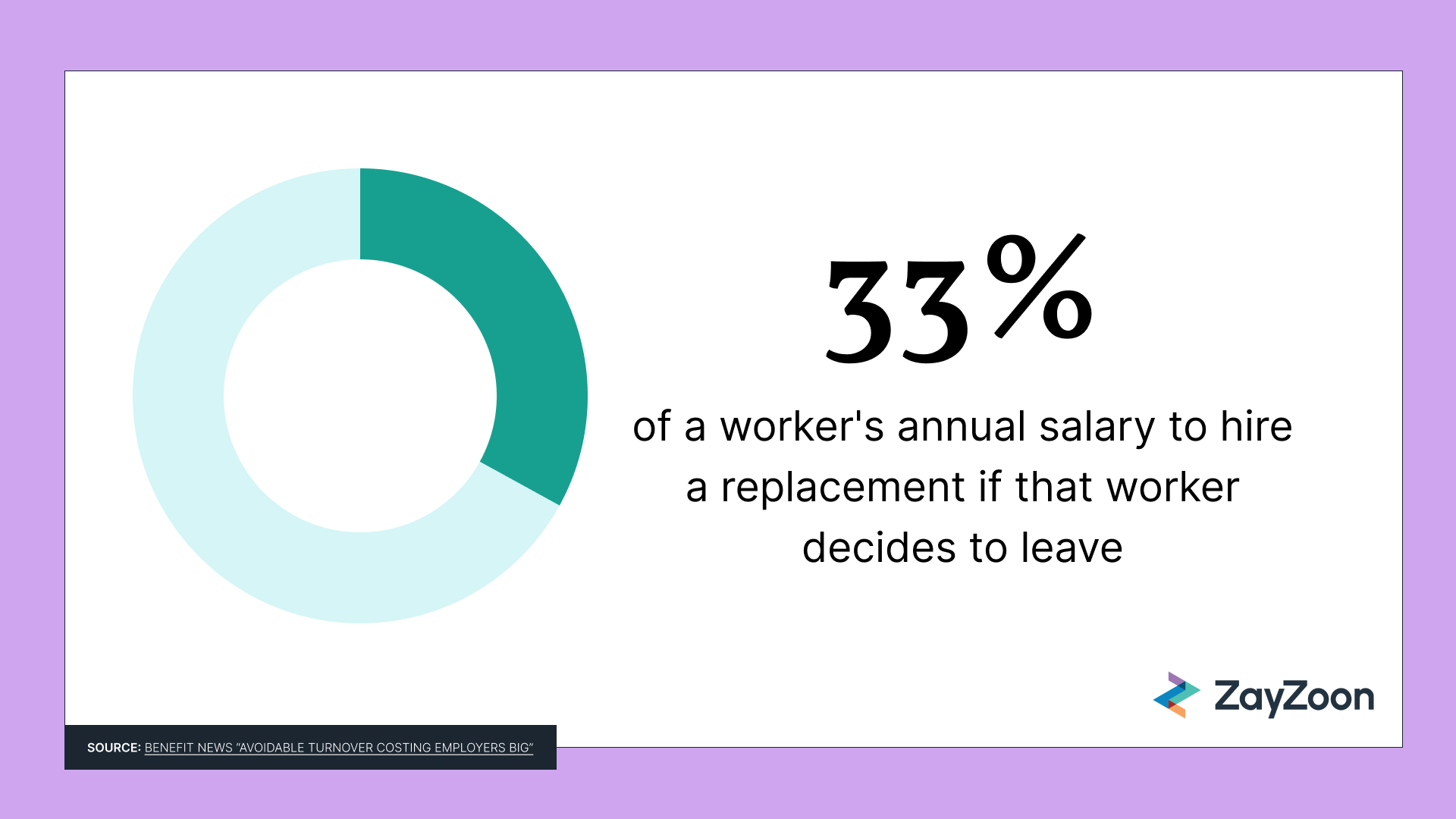
Lost sales
Finally, a high turnover rate is going to directly impact your bottom line. Period.
Look at it this way: If you're focusing on building (or rebuilding) your team, you aren't focusing on cultivating relationships with existing customers and prospects. Not a position any business wants to be in.
Last thing. High turnover rates directly impact office morale which in turn impacts turnover. It's a very, very vicious cycle. At the end of the day, happy employees want to stick around. They're more engaged, productive, and likelier to keep your customers excited about your market offering.
In short, happy employee = happy customers.
Causes of high employee turnover
Obviously there are tons of reasons why companies might be experiencing high turnover. Today, we're going to look at the biggies.
Poor management
They say employees don't leave jobs—they leave managers. I'm not one for cliches, but this one is totally true.
Don't take my word for it. DDI Research finds that 57% of employees quit because of their boss.
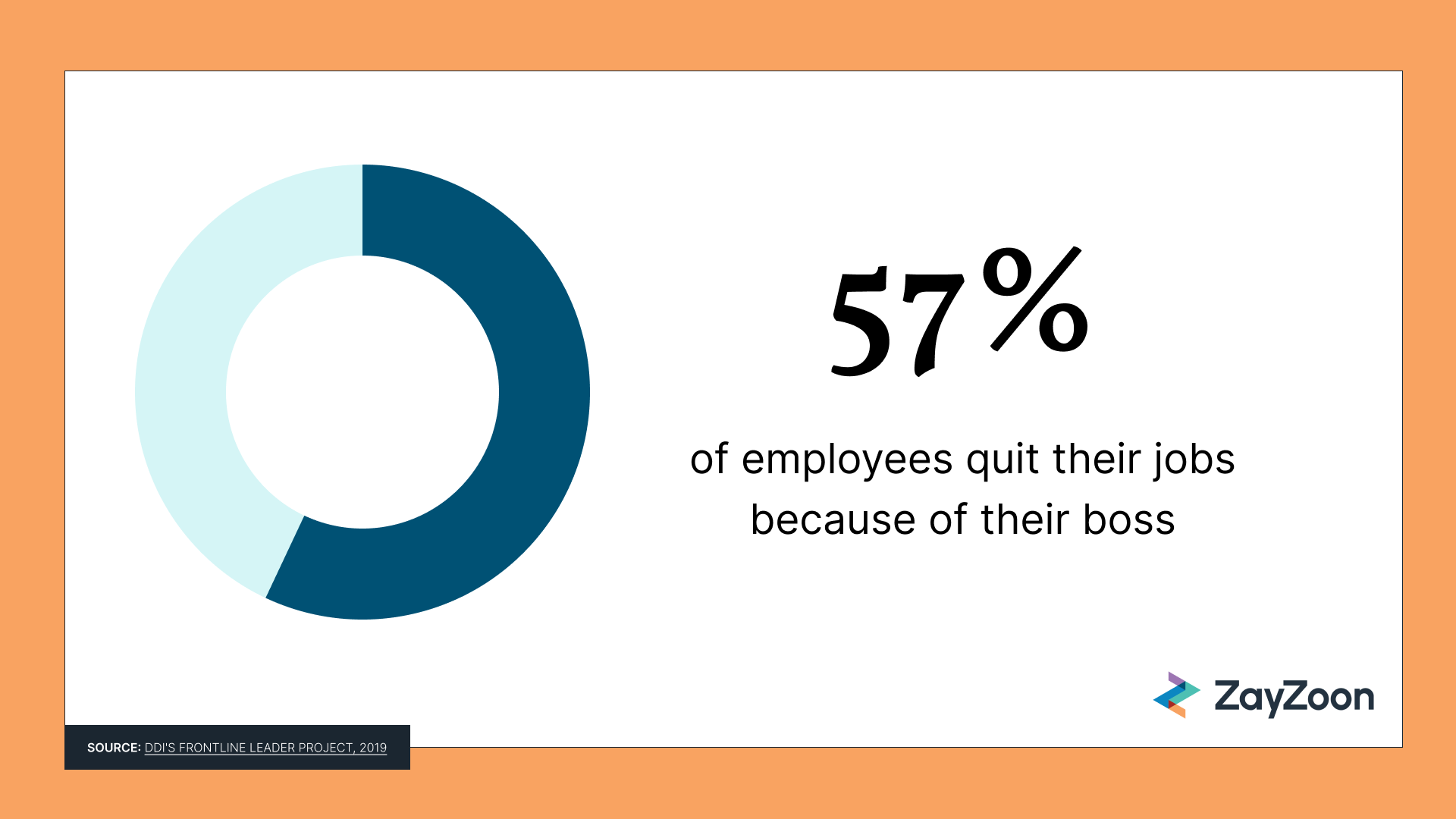
So, the bad manager phenomenon is a real thing. And you should definitely take it seriously.
A toxic work culture
So much has been written about toxic workplace culture.
Unless it's by necessity, nobody wants to work for a toxic business. In fact, a bad company culture is 10.4x likelier to contribute to turnover than compensation.
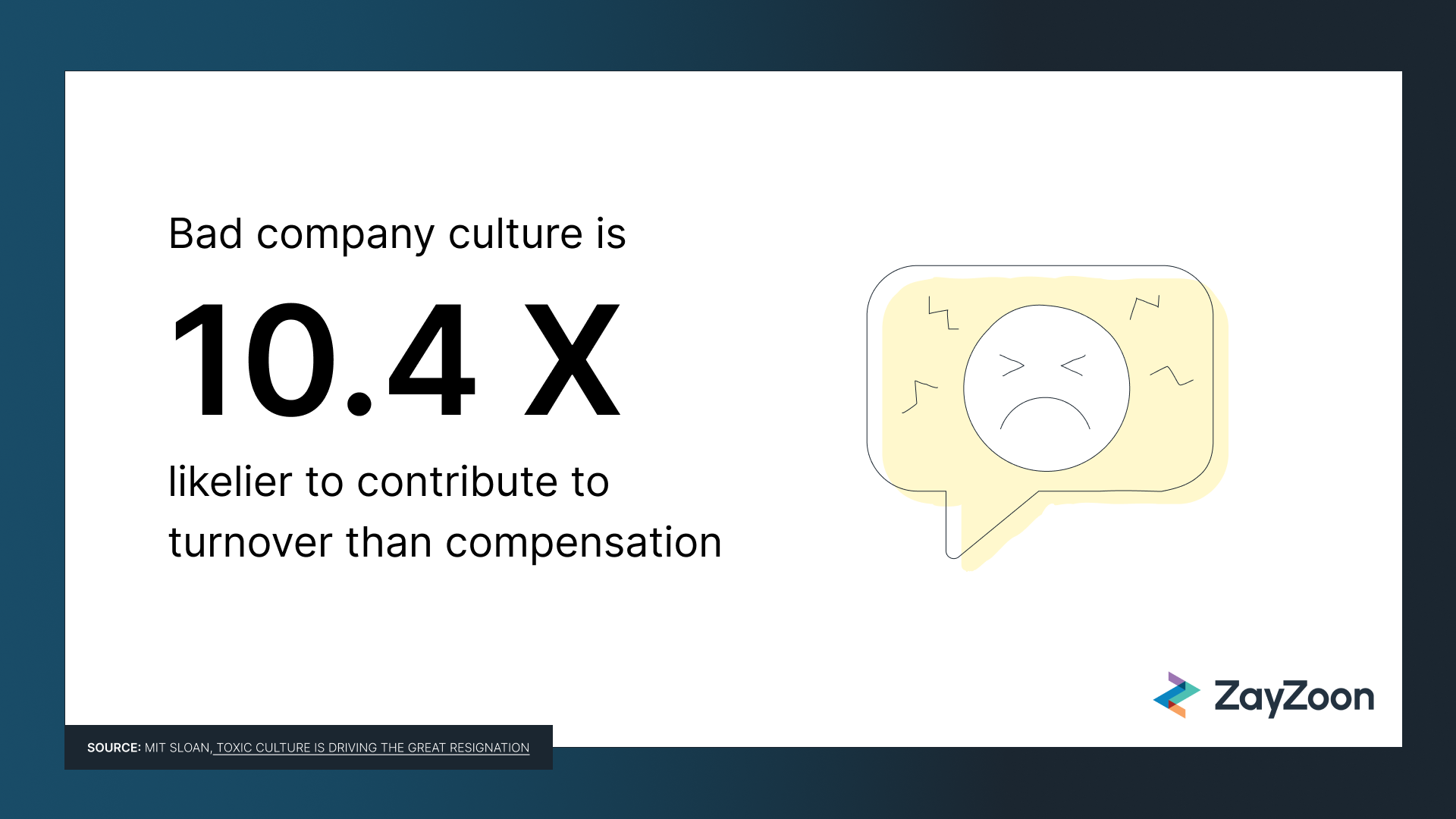
Moral of the story? Fix your company culture before revisiting comp.
Bad work-life balance
This one matters. A lot. Anecdotally, this probably makes a ton of sense to you. In an interview setting, how many candidates have asked you about work hours?
Definitely not zero.
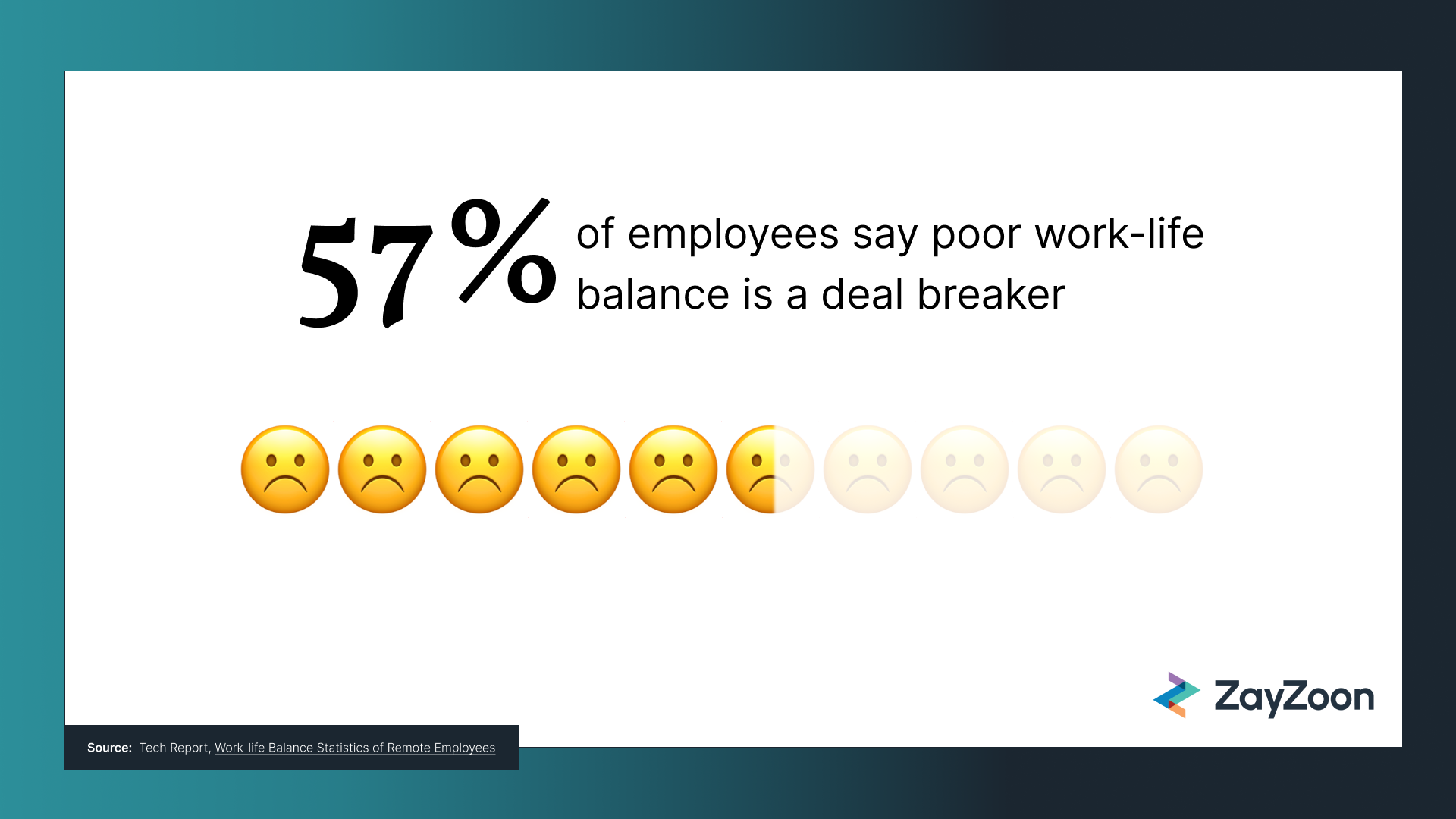
Turns out, 57% of employees say poor work-life balance is a dealbreaker when choosing a new job. So not only does maintaining good work-life balance help with turnover, it helps with your recruitment efforts, too.
A lack of career development opportunities
35% of employees leave their employers for a better career path, according to recent insights from Gartner.
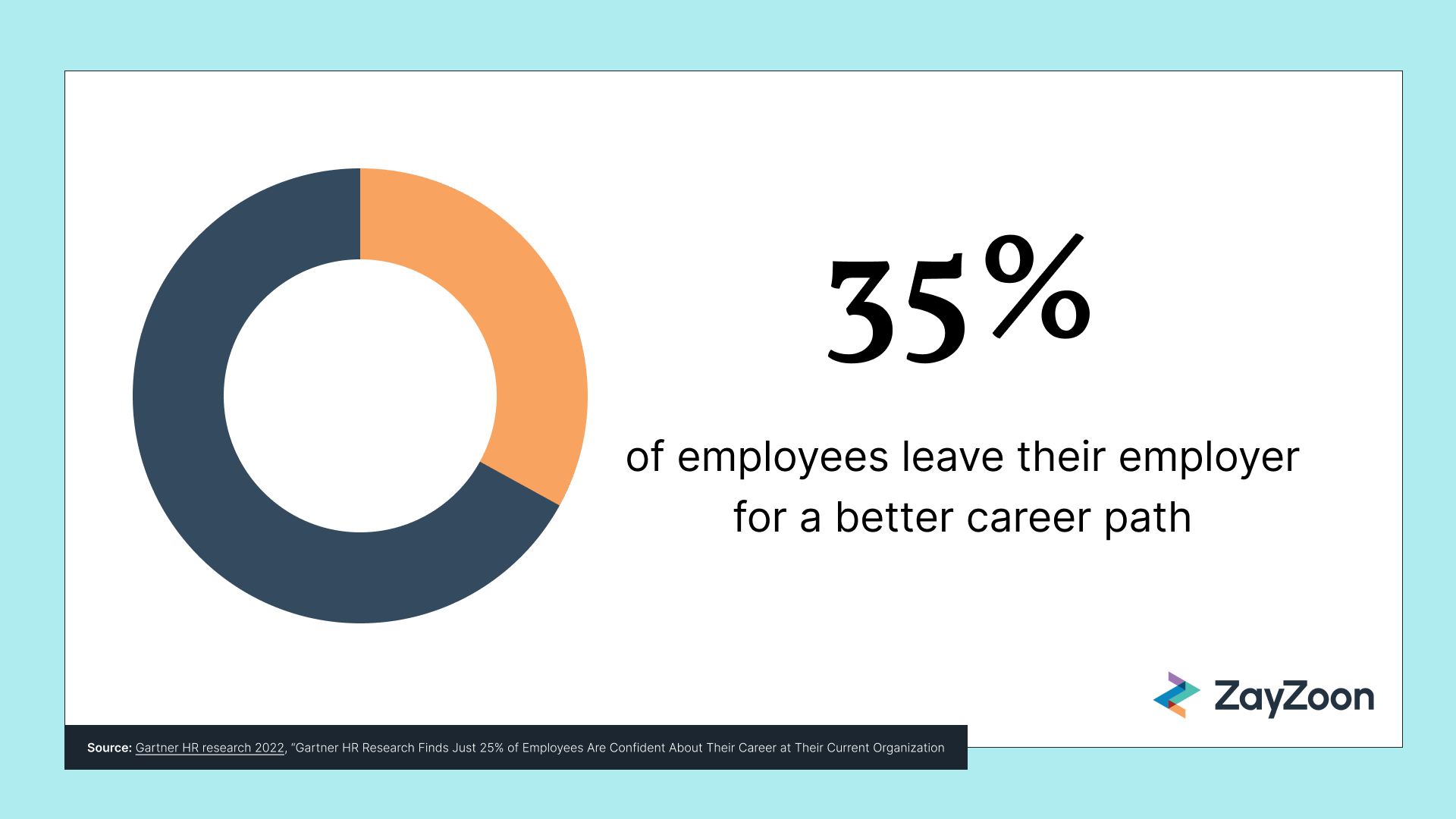
That is a sobering statistic to consider.
Basically, a third of your active employees leave because they can't see a future for themselves in your workplace. Want to curb undesirable turnover? Invest in professional development and career pathing.
Unattractive compensation
Look. As much as we like to pretend employees are sticking around out of the goodness of their own hearts, its important to remind ourselves that, like us, they're in it for the money. Maybe not exclusively. But it does play a role. A very important role.
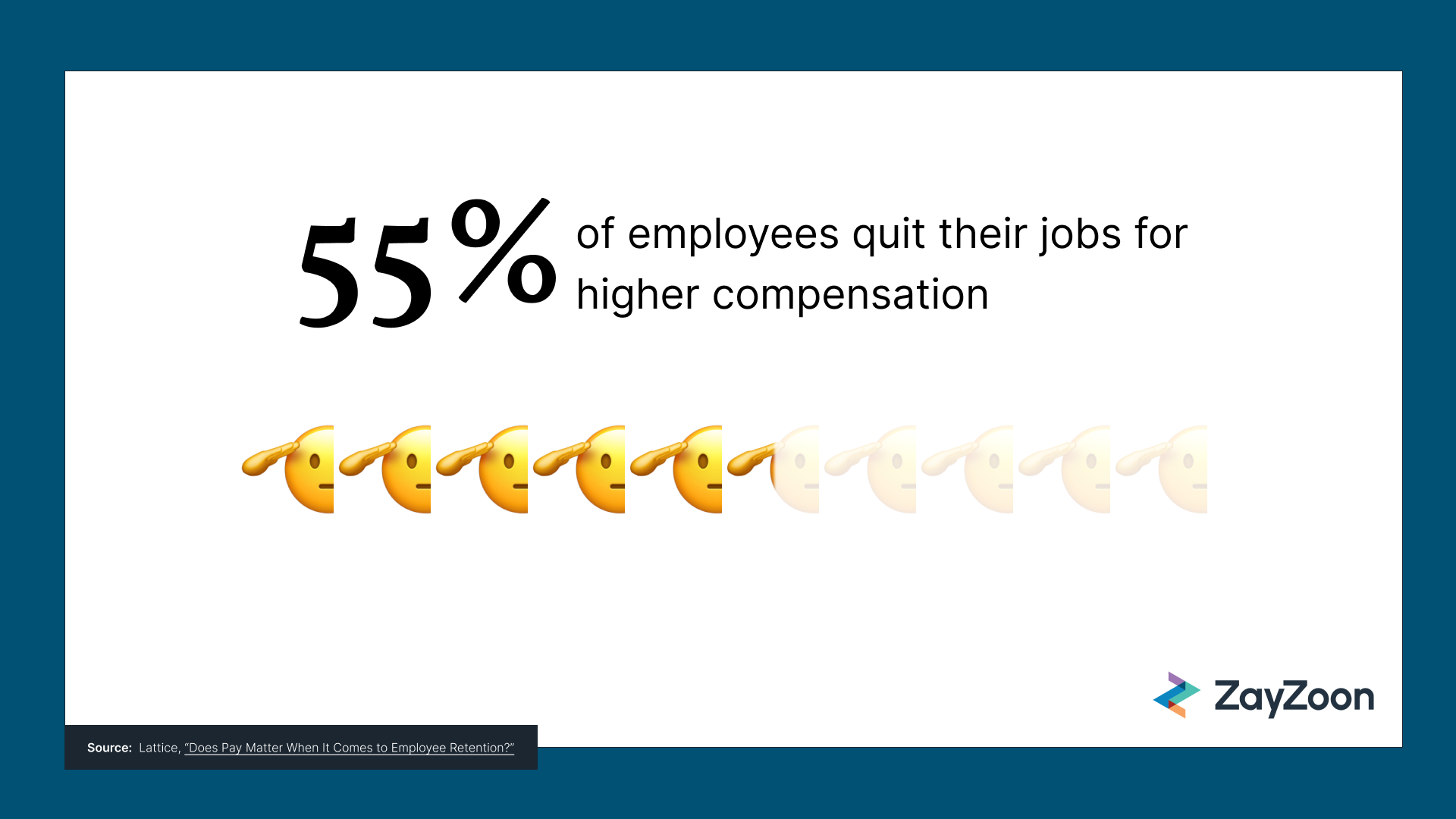
Consider this. 55% of employees quit their jobs for higher compensation.
Those numbers are pretty hard to ignore.
But what exactly do we mean when we say "higher compensation"?
Simple:
-
higher salary
-
bigger bonuses, MBOs, etc.
-
more benefits, from mental health to medical to dental and beyond
-
additional PTO
-
flexible work arrangements
-
etc.
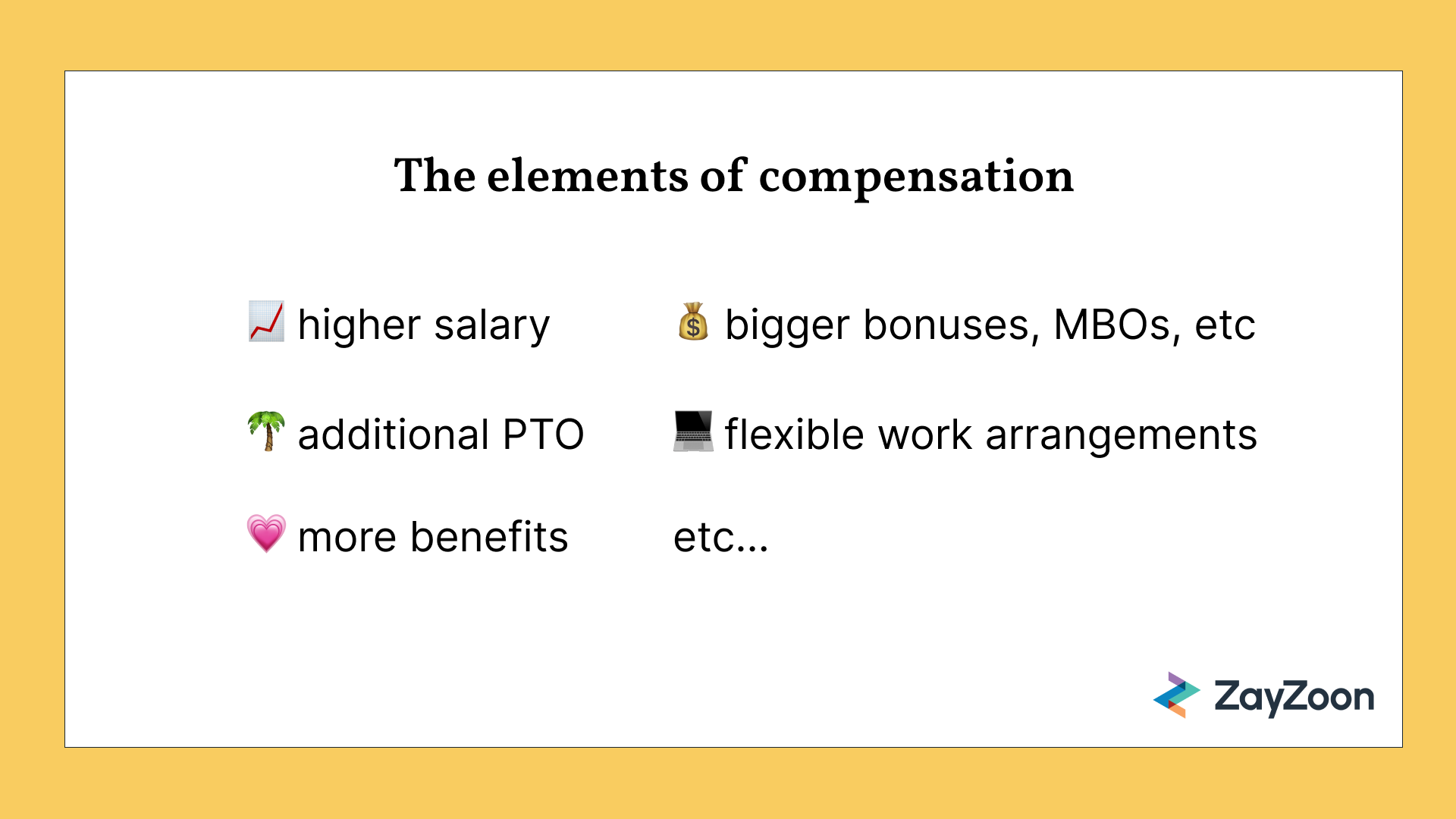
This is all to say that while salary is a MASSIVE component of total comp, it's not the only lever you can pull—and not all levers need cost you an arm and a leg. There are plenty of game-changing benefits that can be the difference maker for you and your business when it comes to slowing turnover.
But more on that later.
How to reduce your employee turnover rate
Now that we've looked at the root causes of high turnover, let's talk about how you can meet or even exceed your industry's average and retain your top talent over the long term.
Explore HR software
I've talked a little bit about this already, but it's worth mentioning briefly again.
One of the undisputed perks of having a human resources management system (or just HRMS) is that it directly helps to reduce employee turnover.
Beyond automating plenty of internal HR processes, like onboarding and offboarding, these tools also provide employee self-service features, which can result in massive time savings for your HR staff.
Beyond securely storing data and giving you insights, HR software can holistically elevate the employee experience, in turn decreasing turnover.
Revisit company culture
Here's the thing. You are your company's culture champion. If you can't speak up about a culture that might need work, who else can?
We've written a ton about culture—from unpacking some of the key initiatives we have to talking industry best practices.
Here's the gist for those strapped for time:
-
establish values that you live by every day and that inform how your team works together and with your customers
-
reward employees for demonstrating values (we do shoutouts)
-
companywide planning and scrums that take input from everyone, no matter how big or small their role
-
team offsites, where employees can connect and collaborate in person but also get to know each other on more personal terms
-
implement some kind of internal messaging tool and be sure to include sub-communities on it where employees can connect over interests
-
drink and thinks, lunch and learns, and whatever else you want to call them—the point is to offer learning opportunities in an informal setting
-
flexible schedules... you've no doubt heard plenty about the expectations of the modern worker; among them, flex work ranks extremely high, so if you can offer it, definitely do so.
Obviously, a list like this can't be exhaustive. At the end of the day, your company culture should empower each of your employees to be a better version of themselves.
Improve your hiring experience
First impressions matter. Most of us can agree on that. But unfortunately, when it comes to candidate experience, a lot of us drop the ball.
By improving your hiring experience, you can improve employee satisfaction and employee engagement, while also reducing new hire turnover rate. Whether you decide on making some tweaks to your process or giving it a complete overhaul, here are some tips on where to get started:
-
job descriptions: filling a new role isn't an iterative process. You should never be figuring out what the job duties for a specific position are while interviewing candidates. That's why it's critical to have comprehensive JDs that outline everything your candidates need to know about the role and your company. And if pay transparency is a legal requirement in your jurisdiction, make sure you're compliant!
-
applicant tracking: there's nothing worse than having a promising candidate fall through the cracks. That's why applicant tracking is so important. Whether you opt for software or build out an internal process doesn't really matter, as long as you have some way of creating touchpoints for candidates. These touchpoints should include live updates, so that candidates can see where they are in your process and what's expected of them.
-
conducting interviews: last thing I'll touch on here: interviews. Standardizing how they're conducted and creating a pleasant experience for candidates is key. That means no unnecessarily long interview cycles or complicated take-home assignments. Even little things like showing up on time go a long way.
Employee training opportunities
Career development should be an integral part of your employee experience. Most companies offer some type of development, whether it be training opportunities, career pathing, or informal mentorship. While that's a great start, there's definitely more you can do.
For the sake of brevity, let's focus on your direct managers and one of the most underrated but impactful initiatives you can kick off today: management training.
If you haven't already, consider offering training to your individual managers. In many cases, these individuals will make or break an employee's experience. Let's face it, for your ICs, managers are the face of your business. As such, they should reflect your values. Beyond that, they need to be able to identify and cultivate unique strengths their team members have and be capable of offering productive feedback that generates personal and professional growth.
Good managers are your front-line defence against high monthly turnover rates. Equipping them with the right resources can make all the difference between whether an employee leaves or sticks around.
Review pay and benefits
If you haven't already, you should definitely conduct market research to determine what the salary benchmarks look like for your industry. Obviously, these will vary depending on certain industries, so keep that in mind. At a bare minimum, you want to be hitting these benchmarks. If you aren't, this is a great place to start. By simply adopting industry standards, you can tackle those turnover numbers.
But that's just a start.
Next, take a look at your total benefits package. Where can you differentiate yourself from competitors? Some of our clients are doing truly remarkable things, like:
-
401(k) matching
-
flex hours
-
higher-than-average number of PTO days
-
formalized training
-
a book budget for employees seeking post-secondary education
-
an education and professional training budget (one of our clients even pays for employees to take correspondence classes at a state college)
-
meal plans
-
the full complement of benefits (and then some, like telehealth, mental health services, pet insurance, etc.)
-
flexible pay with tools like ZayZoon that cost nothing and provide employees with money they've already earned when they need it
This is just the tip of the iceberg. When it comes to pay and benefits there's so much you can do to tackle high turnover rate, employee engagement, and even employee morale. And, thankfully, there are free options to help you close the gap between you and businesses that might have a bigger human resources function.
Bottom line: great places to work have low employee turnover
Reducing a high turnover rate is likely one of the key objectives of anyone working in human resources management. While it might seem daunting and maybe even impossible, it's not. You absolutely can curb those disconcerting turnover rate numbers and begin to improve employee retention. By slowly improving each step in your employee life cycle, you'll begin to see slow improvement. And the benefits are worth it—lower recruitment costs, happier new employees, improved productivity... and the list goes on





